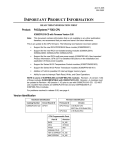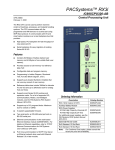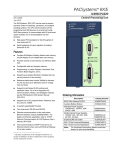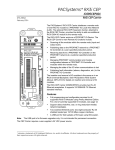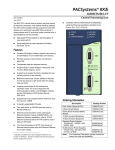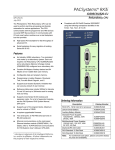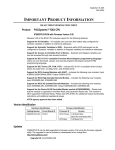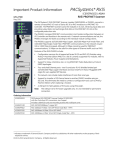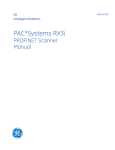Download PACSystems RX3i CPUs, IC695CPU320-AA, FW
Transcript
PACSystems™ RX3i IC695CPU320-AA Central Processing Unit GFK-2488 November 29, 2007 The RX3i CPU can be used to perform real time control of machines, processes, and material handling systems. The CPU communicates with the programmer and HMI devices via a serial port using SNP Slave protocol. It communicates with I/O and smart option modules over a dual backplane bus that provides: ■ ■ CPU OK I/O FORCE RUN OUTPUTS ENABLED BATTERY SYS FLT CPU320 High-speed, PCI backplane for fast throughput of new advanced I/O. RESET STOP Serial backplane for easy migration of existing Series 90-30 I/O RUN I/O ENABLE RUN OUTPUT DISABLE COM 1 Features ■ Contains 64 Mbytes of battery-backed user memory and 64 Mbytes of non-volatile flash user memory. ■ Provides access to bulk memory via reference table %W. ■ Configurable data and program memory. ■ Programming in Ladder Diagram, Structured Text, Function Block Diagram, and C. ■ Supports auto-located Symbolic Variables that can use any amount of user memory. ■ Reference table sizes include 32Kbits for discrete %I and %Q and up to 32Kwords each for analog %AI and %AQ. ■ Supports most Series 90-30 modules and expansion racks. For a list of supported I/O, Communications, Motion, and Intelligent modules, see the PACSystems RX3i System Manual, GFK-2314. ■ Supports up to 512 program blocks. Maximum size for a block is 128KB. ■ In-system upgradeable firmware. ■ Two serial ports: an RS-485 serial port and an RS-232 serial port. ■ Ethernet communications via the rack-based Ethernet Interface module (IC695ETM001). For details on Ethernet capabilities, refer to TCP/IP Ethernet Communications for PACSystems User’s Manual, GFK-2224. ■ PLC time synchronization to SNTP Time Server on Ethernet network when used with Ethernet Release 5.0 or later module. COM1 ACTIVE COM2 ACTIVE COM 2 BATT Ordering Information Description Catalog Number RX3i 1GHz Celeron M CPU IC695CPU320 Auxiliary Battery Module IC693ACC302 RX3i Power Supplies 40 Watt High Capacity Universal AC 40 Watt High Capacity 24 VDC For additional power supplies, see the PACSystems RX3i System Manual, GFK-2314. IC695PSA040 IC695PSD040 [Optional] RS-232 Cable IC200CBL001 Rx3i Standard 12 Slot Rack IC695CHS012 Rx3i Standard 16 Slot Rack IC695CHS016 Note: For Conformal Coat option, please consult the factory for price and availability. 2 RX3i CPU320 GFK-2488 CPU320 Specifications Battery: Memory retention Estimated 30 days using an IC693ACC302 Auxiliary Battery Module at 20ºC. For details on the operation of the Auxiliary Battery Module, refer to the datasheet, GFK-2124. Note: The IC698ACC701 Lithium Battery Pack is not compatible with the CPU320. Program storage Up to 64 Mbytes of battery-backed RAM 64 Mbytes of non-volatile flash user memory Power requirements +3.3 VDC: 1.0 Amps nominal +5 VDC: 1.2 Amps nominal Operating Temperature 0 to 60°C (32°F to 140°F) Floating point Yes Boolean execution speed, typical 0.047 ms per 1000 Boolean contacts/coils Time of Day Clock accuracy Maximum drift of 2 seconds per day Elapsed Time Clock (internal timing) accuracy 0.01% maximum Embedded communications RS-232, RS-485 Serial Protocols supported Modbus RTU Slave, SNP, Serial I/O Backplane Dual backplane bus support: RX3i PCI and 90-30-style serial PCI compatibility System designed to be electrically compliant with PCI 2.2 standard Program blocks Up to 512 program blocks. Maximum size for a block is 128KB. Memory %I and %Q: 32Kbits for discrete %AI and %AQ: configurable up to 32Kwords %W: configurable up to the maximum available user RAM Symbolic: configurable up to 64 Mbytes Note For environmental specifications and compliance to standards (for example, FCC or European Union Directives), refer to the PACSystems RX3i System Manual, GFK-2314. Product Documentation PACSystems CPU Reference Manual, GFK-2222 TCP/IP Ethernet Communications for PACSystems User’s Manual, GFK-2224 TCP/IP Ethernet Communications for PACSystems Station Manager Manual, GFK-2225 PACSystems RX3i System Manual, GFK-2314 C Programmer’s Toolkit for PACSystems User’s Manual, GFK-2259 Proficy® Machine Edition Getting Started, GFK-1868 Proficy® Logic Developer – PLC, GFK-1918 RX3i CPU 3 GFK-2488 Release Information Firmware release 5.10 contains the new features listed in “New Features and Enhancements in Release 5.10.” This release supports Proficy Process Systems Release 1.00. Release History Catalog Number Firmware Version Date 5.10 Nov. 2007 IC695CPU320-AA Upgrades Future versions of IC695CPU320 can be returned to firmware version 5.10 using upgrade kit 82A1145-MS10-000-A1, available at http://www.gefanuc.com/support. New Features and Enhancements in Release 5.10 The IC695CPU320 provides enhanced performance compared to the existing IC695CPU310. For a comparison between CPU320 and CPU310 performance data, see page 9. CPU Functional Compatibility Subject Description Programmer Version Requirements Proficy® Machine Edition Logic Developer 5.70 SIM2 Build A is required to use the Release 5.10 features with the RX3i CPU320 C Toolkit Compatibility C Toolkit Release 5.00 Build 16C1 is required when the PACSystems CPU contains firmware Release 5.00 or later. Note: All C blocks must be recompiled using the new toolkit before downloading to a PLC CPU that contains Release 5.00 or later firmware. Backplanes, power supplies and system modules As listed in the PACSystems RX3i System Manual, GFK-2314C or later. Series 90-30 Expansion Rack Compatibility The PACSystems RX3i supports Series 90-30 expansion racks, both local and remote. PACSystems RX3i CPUs do not operate in a Series 90-30 Rack. Series 90-30 Main Rack Compatibility Series 90-30 Main Racks cannot be used in a PACSystems RX3i system. Series 90-30 CPUs do not operate in PACSystemsRX3i Racks. Isolated 24V power In applications that use the IC69xALG220/221/222, consult PACSystems RX3i System Manual, GFK-2314 for details of wiring the 24V power. COMMREQ to PBM300 In Release 3.0, the behavior of the COMMREQ fault output on a COMMREQ sent to the PROFIBUS master module IC695PBM300 had been changed to be compatible with the Series 90-30 CPU366 PROFIBUS Master. Previously, the fault output is enabled when the module receives a COMMREQ and it is busy. Now, the busy condition does not result in the fault output enabled. 4 RX3i CPU320 GFK-2488 Subject Description Recommended IC200ALG240 revision When a VersaMax™ system Genius® Network Interface Unit (IC200GBI001) interoperates with a Genius Bus Controller located in a PACSystems PLC, and the VersaMax system contains an IC200ALG240 Analog Input Module, it is recommended to update the IC200ALG240 firmware to at least Revision 1.10. However, it is preferable to update the IC200ALG240 firmware to Revision 1.20, which contains resolutions for all issues found after Revision 1.10. Upgrade kits are available at http://www.gefanuc.com/support. Use firmware update kit 44A752313-G01 to update the IC200ALG240 firmware to Revision 1.10, or upgrade kit 44A752313-G02 to update the IC200ALG240 firmware to Revision 1.20. Configuration of IC694MDL754 Always configure 16 bits of module status when using this module. Configuring 0 bits of module status will result in invalid data in the module’s ESCP status bits. CPU Restrictions and Open Issues Subject Description Hot Swapping some Analog modules slowly causes these modules to delay in reporting input values. Occasionally during a hot insertion (hot swap) of IC695 Non-Isolated Analog Input Modules, input channels may take up to 2 seconds to reflect actual input values after the module OK bit is enabled in the module status word. This delay has only occurred when the hot insertion has been done slowly (i.e. approximately 1.5 seconds to insert the module) Ethernet Disconnect During Word-for-Word Change If the Ethernet connection is broken during a word-for-word change, the programmer may not allow a subsequent word-for-word change after reconnecting due to the fact that it thinks another programmer is currently attached. If this occurs, you should go offline and then back online again. Simultaneous Clears, Loads and Stores Not Supported Currently, PACSystems CPUs do not support multiple programmers changing CPU contents at the same time. The programming software may generate an error during the operation. Simultaneous loads from a single PLC are allowed. Hardware Configuration Not Equal After Changing Target Name If the user stores a hardware configuration to flash that sets “Logic/Config Power up Source” to “Always Flash” or “Conditional Flash” and then subsequently changes the name of the target in the programming software, the hardware configuration will go Not Equal and will not Verify as equal. PLC and IO Fault Tables May Need to be Cleared Twice to Clear Faulted State Both PLC and IO fault tables may need to be cleared to take the CPU out of Stop/Fault mode. If one of the tables contains a recurring fault, the order in which the tables are cleared may be significant. If the CPU is still in Stop/Fault mode after both tables are cleared, try clearing the fault tables again. Setting Force On/Off by Storing Initial Value Once a force on or force off has been stored to the PLC, the user cannot switch from force on to force off or vice-versa directly by downloading initial values. The user can turn off the force by doing a download, and then change the force on or off by another download. Number of Active Programs Returned as Zero The SNP request Return Controller Type and ID currently returns the number of active programs as zero. Serial I/O Failure at 115K During Heavy Interrupt Load Rare data corruption errors have been seen on serial communications when running at 115K under heavy interrupt load on the PLC. Under heavy load applications, users should restrict serial communications to 57K or lower. SNP ID not always provided Unlike the Series 90-30, the RX3i CPU’s SNP ID will not appear in the Machine Edition programmer Show Status display. Service Request 11 will always return zeros. Second programmer can change logic while in Test & Edit mode While currently active in a Test and Edit session using Machine Edition on one PC, Machine Edition running on another PC is not prevented from storing new logic to the PLC. RX3i CPU 5 GFK-2488 Subject Description Must Have Logic If PoweringUp From Flash If the application will configure the CPU to retrieve the contents of flash memory at power-up, be sure to include logic along with hardware configuration when saving to flash memory. Otherwise, after the write to flash memory is completed, if power is removed from the CPU then turned back on, the CPU will not retrieve the hardware configuration saved in flash memory during the next power-up, and the Machine Edition programmer will report “Config NE” (configuration not equal) after reconnecting to the CPU. Two loss of module faults for Universal Analog Module Occasionally, the hot removal of the Universal Analog Input Module (IC695ALG600) results in two “Loss of I/O Module” faults instead of one. Power up of HSC may take as long as 20 seconds As power is applied to a 90-30 High-Speed Counter, the "module ready" bit in the status bits returned each sweep from the module may not be set for as long as 20 seconds after the first PLC sweep, even though there is no "loss of module" indication. I/O data exchanged with the module is not meaningful until this bit is set by the module. For details, see “Data Transfer Between High Speed Counter and CPU” in the Series 90-30 High Speed Counter User’s Manual, GFK-0293C. Info fault at power up Intermittently during power-up, an Informational non-critical CPU software fault may be generated with fault extra data of 01 91 01 D6. This fault will have no effect on the normal operation of the PLC. But, if the hardware watchdog timer expires after this fault and before power has been cycled again, then the outputs of I/O modules may hold their last state, rather than defaulting to zero. Extended Memory Types for IO Triggers %R, %W and %M cannot be used as IO triggers. Possible Machine Edition inability to connect Infrequently, an attempt to connect a programmer to a PLC via Ethernet will be unsuccessful. The normal connection retry dialog will not be displayed. Rebooting the computer that is running the programmer will resolve the behavior. SNP Update Datagram message If an Update Datagram message requests 6 or less bits or bytes of data, the PLC will return a Completion Ack without Text Buffer. The protocol specifies that the returned data will be in the Completion Ack message, but it may not be. Series 90-30 GBC may not resume operation after power cycle In rare instances, a Series 90-30 Genius Bus Controller module in an expansion rack may not resume normal operation after a power cycle of either the expansion rack containing the GBC module or the main rack. To recover the GBC, the expansion rack containing the GBC must be power cycled. Configuration of third-party modules Do not specify a length of 0 in the configuration of a third-party module. The module will not work properly in the system. Power supply status after CPU firmware update The PLC will report a “Loss of or missing option module” fault for the IC695PSD140 RX3i power supply following an update of PLC CPU firmware. Also, the slot will appear empty in the programmer’s online status detail view. The power supply continues to operate normally. Power cycle to restore normal status reporting. Power supply status after power cycling Rarely, turning a power supply on or off may not result in an add or loss fault. Also, the slot will appear empty in the programmer’s online status detail view. The power supply continues to operate normally. Power cycle to restore normal status reporting. Do not use multiple targets In a system in which the hardware configuration is stored from one target and logic is stored from a different target, powering-up from flash will not work. The observed behavior is that, following a power up from flash, ME reports hardware configuration and logic "not equal". Missing “Loss of terminal block” fault The IC695ALG600/608/616 analog input modules do not produce a “Loss of terminal block” fault when hardware configuration is stored or the module is hotinserted, and the terminal block is not locked into place. 6 RX3i CPU320 GFK-2488 Subject Description Sequence Store Failure In systems with very large hardware configurations, it is possible to encounter a “PLC Sequence Store Failure” error when writing the configuration to flash. To work around this error, either: 1. Perform an explicit clear of flash prior to performing the write. 2. Increase the operation timeout used by Machine Edition software prior to performing the write. IC694MDL754: Must configure module status bits Always configure 16 bits of module status when using this module. Configuring 0 bits of module status will result in invalid data in the module’s ESCP status bits. IC695ALG600 Lead Resistance Compensation setting A configuration store operation will fail if a channel is configured for 3-wire RTD and Lead Resistance Compensation is set to Disabled. A Loss of Module fault will be logged in the I/O Fault table at the end of the store operation. To recover the lost module, change the configuration to enable Lead Resistance Compensation and power cycle the module WinLoader may stop operating On computers running Windows 2000 and using some versions of Symantec Antivirus protection, WinLoader will fail if used in advanced mode. Recovery requires cycling the computer's power. Simultaneous upload and download failure While downloading a Machine Edition folder to the target over a serial connection established between a Machine Edition session and the target, a simultaneous upload from the same target in a second Machine Edition session established over Ethernet will fail with Error 8523: Unknown Upload Exception. Issues Related to the IC693DNM200 DeviceNet Master Module Please see GFK-2194D or later for open issues related to the IC693DNM200 DeviceNet Master Module. CPU Operational Notes Subject Description Length of Serial I/O buffer (Release 5.10 or later) The "Set Up Input Buffer Function" always allocates a buffer containing 2049 bytes. This is one byte more than previous PACSystems releases. Important Installation Instructions for Battery An IC693ACC302 battery module is recommended for use with the CPU. When installing the battery, do not connect the battery until the CPU is installed in the rack and the rack is powered on. The battery may then be attached to either of the two terminals in the battery compartment. Once that is done, the CPU may be powered down and normal battery back up operation will begin. To save battery life, do not connect the battery for the first time until the CPU is powered up. Note: If installing a battery when there currently is no battery installed, the battery must be installed while the CPU has power. Failure to follow this procedure could result in the CPU not powering up. If a battery is installed while power is off (and there was no battery previously installed), and the CPU fails to power up, remove the battery, power cycle the CPU and then install the battery. Small batteries that fit in the battery compartment on the faceplate are not recommended for use with the CPU. Indication of low battery capacity When power is cycled to a PLC with a battery attached, a “Corrupted user memory” fault (group 130, error code 7) will appear in the CPU fault table when the battery capacity is low. LD-PLC operations Machine Edition LD-PLC no longer supports a function that connects to the PLC, downloads, then disconnects from the PLC. The connect and download functions are now separate. To perform a download to the PLC, you must first connect to the PLC. RX3i CPU 7 GFK-2488 Subject Description Changing IP Address of Ethernet Interface While Connected Storing a hardware configuration with a new IP address to the RX3i while connected via Ethernet will succeed, then immediately disconnect because the RX3i is now using a different IP address than the Programmer. You must enter a new IP address in the Target Properties in the Machine Edition Inspector window before reconnecting. Duplicate Station Address for Modbus will Conflict with Other Nodes The default serial protocol for the RX3i is Modbus RTU. The default Station Address is 1. If the PLC is added to a multi-drop network, care must be taken that the PLC is configured with a unique Station Address. Nodes with duplicate Station Addresses on the same network will not work correctly. Timer Operation Care should be taken when timers (ONDTR, TMR, and OFDTR) are used in program blocks that are NOT called every sweep. The timers accumulate time across calls to the sub-block unless they are reset. This means that they function like timers operating in a program with a much slower sweep than the timers in the main program block. For program blocks that are inactive for large periods of time, the timers should be programmed in such a manner as to account for this catch up feature. Related to this are timers that are skipped because of the use of the JUMP instruction. Timers that are skipped will NOT catch up and will therefore not accumulate time in the same manner as if they were executed every sweep. Constant Sweep Constant Sweep time, when used, should be set at least 10 milliseconds greater than the normal sweep time to avoid any over-sweep conditions when monitoring or performing on-line changes with the programmer. Window completion faults will occur if the constant sweep setting is not high enough. Large Number of COMMREQs Sent to Module in One Sweep Causes Faults A large number of COMMREQs (typically greater than 8) sent to a given board in the same sweep may cause Module Software faults to be logged in the PLC fault table. The fault group is MOD_OTHR_SOFTWR (16t, 10h) and the error code is COMMREQ_MB_FULL_START (2). When this occurs, the “FT” output of the function block will also be set. To prevent this situation, COMMREQs issued to a given board should be spread across multiple sweeps so that only a limited number (typically 8 or less) of COMMREQs are sent to a given board in each sweep. In addition, the FT output parameter should be checked for errors. If the FT output is set (meaning an error has been detected), the COMM_REQ could be re-issued by the application logic. C Block Standard Math Functions Do Not Set errno In C Blocks, standard math functions (e.g. sqrt, pow, asin, acos) do not set errno to the correct value and do not return the correct value if an invalid input is provided. Upgrading Firmware The process of upgrading the CPU firmware with the WinLoader utility may fail when multiple IO modules are in the main rack, due to the time it takes to power cycle the rack system. If the upgrade process fails, move the CPU to a rack without IO modules and restart the upgrade process. The Winloader initial connect baud rate is fixed at 19200 baud. Note that the firmware download will occur at 115.2K baud by default. Note that if you have hyperterm open on a port, and then try to use Winloader on the same port, Winloader will often say “Waiting for Target” until the hyperterm session is closed. Hot Swap Hot Swap of power supplies or CPUs is not supported in this release 8 RX3i CPU320 GFK-2488 Subject Description No serial Communication with CPU Warning The following combination of circumstances may render serial communications with the CPU impossible: Ethernet module is not present in main rack. User configuration disables the Run/Stop switch User configures the power up mode to Run or Last Logic is stored in FLASH and user configures CPU to load from FLASH on powerup. User application issues COMMREQs that set the protocol on both serial ports to something that does not permit communications to the Machine Edition programmer. Incorrect COMMREQ Status For Invalid Program Name The program name for PACSystems is always "LDPROG1". When another program name is used in a COMM_REQ accessing %L memory, an Invalid Block Name (05D5) error is generated. FANUC I/O Master and Slave operation Scan sets on the master do not work properly for the first operation of the scan set after entering RUN mode. They do work properly for subsequent scans. After downloading a new hardware configuration and logic, a power cycle may be required to resume FANUC I/O operation. Use PLCs of similar performance in FANUC I/O networks. If a master or slave is located in an RX3i system, the other PLCs should be RX3is or Series 90-30 CPU374s. Repeated power up/down cycles of an expansion rack containing FANUC I/O slaves may result in failure of the slaves’ operation, with the RDY LED off. Lost count at power up for Special IO Processor The special IO Processor (IC693APU305) will lose the first count after every power up or every time the module receives a configuration. COMMREQ Status Words Declared in Bit Memory Types Must Be ByteAligned In previous releases, the CPU allowed configuration of COMMREQ Status Words in bit memory types on a non-byte-aligned boundary. Even though the given reference was not byte-aligned, the firmware would adjust it the next-lowest byte boundary before updating status bits, overwriting the bits between the alignment boundary and specified location. To ensure that the application operates as expected, release 3.50 requires configuration of COMMREQ Status Words in bit memory types to be bytealigned. For example if the user specified status bit location of %I3, the CPU aligns the status bit location at %I1. Release 3.50 firmware requires the user to specify the appropriate aligned address (%I1) to ensure that the utilized location is appropriate for their application. Note that the actual reference location utilized is not changed, but now is explicitly stated for the user. RX3i CPU 9 GFK-2488 Performance Data The following Performance Data for the IC695CPU320 was measured for this Release of the PLC CPU firmware (Release 5.10). See Appendix A of the PACSystems CPU Reference Manual, GFK-2222 for explanation of the data. Base Sweep Times CPU Mode IC695CPU310 (µsecs) IC695CPU320 (µsecs) Run + I/O enabled 462 180 Run + I/O disabled 454 176 RX3i I/O Module Types Type Part Numbers Discrete Input (16 point) IC694MDL240, IC697MDL241, IC694MDL645, IC694MDL646 Discrete Input (32 point) IC694MDL654, IC694MDL655, IC697MDL654 Discrete Output (8 point) IC694MDL330, IC694MDL732, IC694MDL930, IC694MDL940 Discrete Output (16 point, 12 point) IC694MDL340, IC694MDL341, IC694MDL740, IC694MDL741 Discrete Output (32 point) IC694MDL350, IC694MDL340, IC694MDL752, IC694MDL753 IC694MDL742, IC694MDL940 Discrete In/Out (8 point) IC693MDR390, IC693MAR590 Analog Input (16 Channel) IC694ALG222, IC694ALG223 Analog Output (2 channel) IC694ALG390, IC394ALG391 RX3i Module Sweep Impact Times Note: The base case provides the overhead for the case when a single module is present in the rack. The increment (Inc) refers to the overhead for each similar module that is added. IC695CPU320 (µsec) Main Rack IC695CPU310 (µsec) Expansion Rack Main Rack Expansion Rack Base Inc Base Inc Base Inc Base Inc Discrete Input 16 point 37 35 68 66 57.1 41.4 87.6 74.4 Discrete Input 32 point 56 55 86 86 78.4 59.7 105.9 96.1 Discrete Output 8 point 36 35 65 65 61.0 40.3 84.3 74.9 Discrete Output 16 point 35 34 65 65 61.5 38.9 87 74.4 Discrete Output 32 point 54 50 82 82 79.7 57 101.8 90.6 Discrete Mixed 8 point in/ 8 point out 72 69 132 131 104.5 85.7 167 151.7 Analog Input/Output 4 channel 94 92 125 123 114.9 99 142.7 132 Analog Input 16 channel 385 379 500 499 427.7 407.1 538.8 538 Analog Output 2 channel Universal Analog IC695ALG600 New Modules: Analog Input 8 channel IC695ALG608 Analog Input 16 channel IC695ALG616 Analog Output 4 channel IC695ALG704 Analog Output 8 channel IC695ALG708 70 51 67 46 129 N/A 128 N/A 98.3 90.3 80.8 77.2 154.4 N/A 143.4 N/A 43 40 N/A N/A 84.4 68.3 N/A N/A 56 56 N/A N/A 99.5 82.6 N/A N/A 55 48 N/A N/A 122 101.8 N/A N/A 55 50 N/A N/A 121.6 103.3 N/A N/A 10 RX3i CPU320 GFK-2488 Sweep Impact Times for Intelligent Option Modules IC695CPU310 (µsec) IC695CPU320 (µsec) ETM (Peripheral Ethernet Module) 199 188 High Speed Counter (APU300) 1085 1109 PROFIBUS Master No I/O 100 bytes Input, 100 bytes Output 100 bytes Input, 200 bytes Output 200 bytes Input, 100 bytes Output 132 196 206 248 60 105 106 140 Sweep Impact Item I/O Interrupt Block Performance and Sweep Impact Times Sweep Impact Item IC695CPU310 (µsec) I/O interrupt sweep impact 127.8 Minimum response time Typical response time Maximum response time 451.8 475.0 602.7 IC695CPU320 (µsec) 326.057 327.302 346.234 Note that the minimum, typical, and maximum response times include a 300 µsec Input card filter time. Timed Interrupt Sweep Impact Time IC695CPU310 (µsec) IC695CPU320 (µsec) Timed interrupt sweep impact 71.3 26.174 Minimum interrupt period Typical interrupt period Maximum interrupt period 928 999.9 1071 969.7 999.9 1030.8 Sweep Impact Item Installation in Hazardous Locations The following information is for products bearing the UL marking for Hazardous Locations: WARNING - EXPLOSION HAZARD - SUBSTITUTION OF COMPONENTS MAY IMPAIR SUITABILITY FOR CLASS I, DIVISION 2; WARNING - EXPLOSION HAZARD - WHEN IN HAZARDOUS LOCATIONS, TURN OFF POWER BEFORE REPLACING OR WIRING MODULES; AND WARNING - EXPLOSION HAZARD - DO NOT CONNECT OR DISCONNECT EQUIPMENT UNLESS POWER HAS BEEN SWITCHED OFF OR THE AREA IS KNOWN TO BE NONHAZARDOUS. EQUIPMENT LABELED WITH REFERENCE TO CLASS I, GROUPS A, B, C & D, DIV. 2 HAZARDOUS LOCATIONS IS SUITABLE FOR USE IN CLASS I, DIVISION 2, GROUPS A, B, C, D OR NON-HAZARDOUS LOCATIONS ONLY The tightening torque range for the control terminals is 9.6-11.5 in. lb. Use only wire rated for 90°C. Be sure to observe any additional ratings that are provided with the modules.










